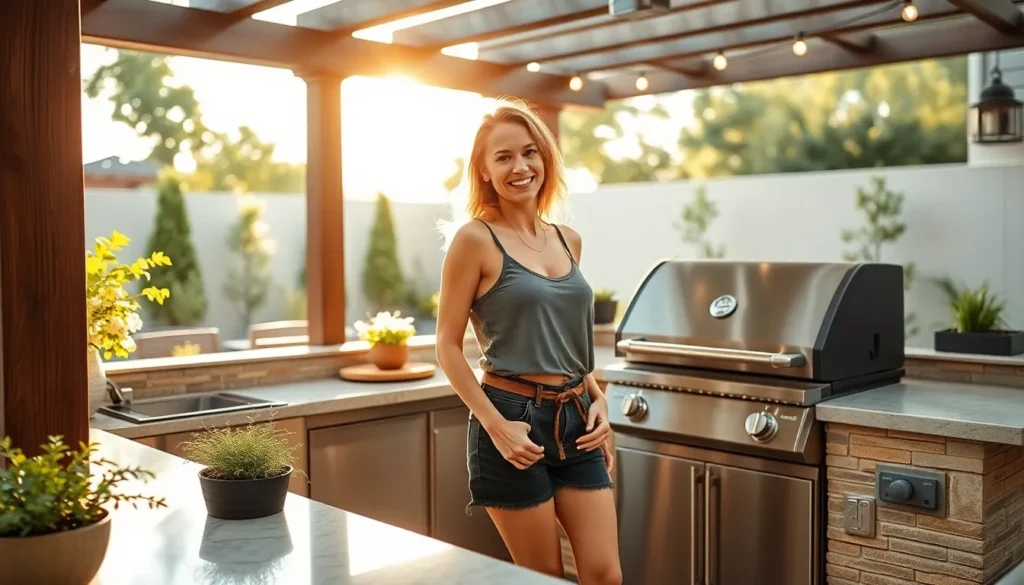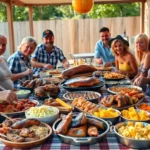We’ve all dreamed of that perfect backyard oasis where grilling meets gourmet cooking under the open sky. Outdoor kitchen BBQ setups transform ordinary patios into culinary command centers that’ll make your neighbors seriously jealous. Whether you’re working with a sprawling deck or a cozy corner space there’s an outdoor kitchen solution that fits your vision and budget.
From sleek modern islands with built-in gas grills to rustic stone setups featuring traditional smokers we’re diving into the hottest trends that’ll elevate your outdoor entertaining game. These aren’t just cooking spaces – they’re lifestyle upgrades that add serious value to your home while creating unforgettable memories with family and friends.
Ready to turn your backyard into the ultimate outdoor cooking destination? We’ll explore innovative design ideas practical layouts and must-have features that’ll help you create an outdoor kitchen that’s both functional and absolutely stunning.
Choose the Perfect Location for Your Outdoor Kitchen BBQ Setup
Strategic location planning ensures your outdoor kitchen BBQ setup delivers maximum functionality and enjoyment. We’ll guide you through essential factors that make the difference between a mediocre setup and an exceptional outdoor cooking space.
Consider Proximity to Indoor Kitchen and Utilities
Positioning your outdoor kitchen BBQ within 20-30 feet of your indoor kitchen creates seamless meal preparation workflows. This distance allows us to transport ingredients, seasonings, and serving dishes without long walks that interrupt cooking timing.
Water access becomes critical when locating your outdoor BBQ setup near existing plumbing lines. We recommend connecting to municipal water systems rather than well water to maintain consistent pressure for cleaning stations and prep sinks.
Electrical connections should be within 100 feet of your main panel to minimize installation costs for GFCI outlets, lighting circuits, and appliance connections. Licensed electricians typically charge 30-40% more for longer wire runs beyond standard distances.
Gas line extensions work best when outdoor kitchens sit within 50 feet of existing natural gas meters or propane tank locations. This proximity reduces trenching costs and ensures adequate BTU delivery to high-powered grills and side burners.
Evaluate Wind Patterns and Weather Protection
Wind direction analysis protects your outdoor cooking experience from smoke interference and temperature control issues. We suggest observing prevailing winds during different seasons before finalizing your BBQ location.
Dominant wind patterns in most regions flow from west to east, so positioning grills on the eastern side of structures provides natural windbreaks. This placement prevents smoke from drifting toward seating areas and neighboring properties.
Weather protection features like pergolas, retractable awnings, or permanent roof structures extend your cooking season by 3-4 months annually. These additions shield equipment from rain damage and provide comfortable spaces during light precipitation.
Natural barriers such as mature trees, fence lines, or industry walls create microclimates that reduce wind speeds by 40-60%. We recommend maintaining 10-15 feet clearance from overhead branches to prevent fire hazards and falling debris.
Plan for Adequate Space and Traffic Flow
Cooking zones require minimum 4-foot clearances on all sides for safe operation and comfortable movement around hot surfaces. Professional outdoor kitchen designers allocate 6-8 feet behind cooking equipment for multiple users.
Traffic patterns should create triangular workflows between prep areas, cooking surfaces, and serving stations similar to indoor kitchen designs. This configuration reduces steps and improves efficiency during meal preparation.
Seating arrangements need 8-10 feet separation from active grilling areas to protect guests from heat and splatter while maintaining social interaction. Bar height counters work well for casual dining and conversation spaces.
Storage accessibility impacts daily use significantly, so we position frequently used items within arm’s reach of primary cooking stations. Weather resistant cabinets and drawers should open away from cooking areas to prevent interference during meal preparation.
Select the Right BBQ Grill for Your Outdoor Kitchen Design

Choosing the perfect grill becomes the cornerstone of any successful outdoor kitchen BBQ design. Your selection will influence everything from cooking capabilities to overall aesthetic appeal.
Compare Gas vs. Charcoal vs. Pellet Grilling Options
Gas grills deliver unmatched convenience with instant ignition and precise temperature control that makes weeknight cooking effortless. We recommend these for busy families who prioritize quick meal preparation without sacrificing quality results.
Charcoal grills produce that authentic smoky flavor profile that gas simply can’t replicate. These units reach higher temperatures ideal for perfect searing while offering that traditional BBQ experience many outdoor cooking enthusiasts crave.
Pellet grills combine the best of both worlds by using wood pellets for fuel while providing digital temperature controls. These versatile units excel at both smoking and slow cooking applications that expand your outdoor culinary repertoire significantly.
Your taste preferences and cooking style should guide this decision alongside your willingness to handle maintenance requirements for each grill type.
Determine Grill Size Based on Entertaining Needs
Small grills work perfectly for casual family meals where you’re cooking for 4 people or fewer on a regular basis. These compact units fit seamlessly into smaller outdoor kitchen designs without overwhelming the space.
Large grills become essential when you frequently host backyard parties or entertain groups of 8 or more guests regularly. Multiple grilling stations can also solve capacity issues while allowing you to cook different foods simultaneously without delays.
Consider your entertaining frequency and typical guest count to avoid investing in more capacity than you’ll realistically use throughout the year.
Consider Built-In vs. Portable Grill Answers
Built-in grills integrate seamlessly into permanent outdoor kitchen islands creating that professional cooking station appearance. These units require ample space and fixed installation but provide the most robust cooking capabilities for serious outdoor chefs.
Portable grills offer flexibility for homeowners who want cooking options that adapt to different occasions or seasonal use. These units work exceptionally well for smaller spaces or rental properties where permanent installations aren’t practical.
Built-in options suit homeowners committed to long-term outdoor entertaining while portable answers serve those seeking versatility and space-saving storage capabilities.
Design Functional Counter Space and Food Prep Areas
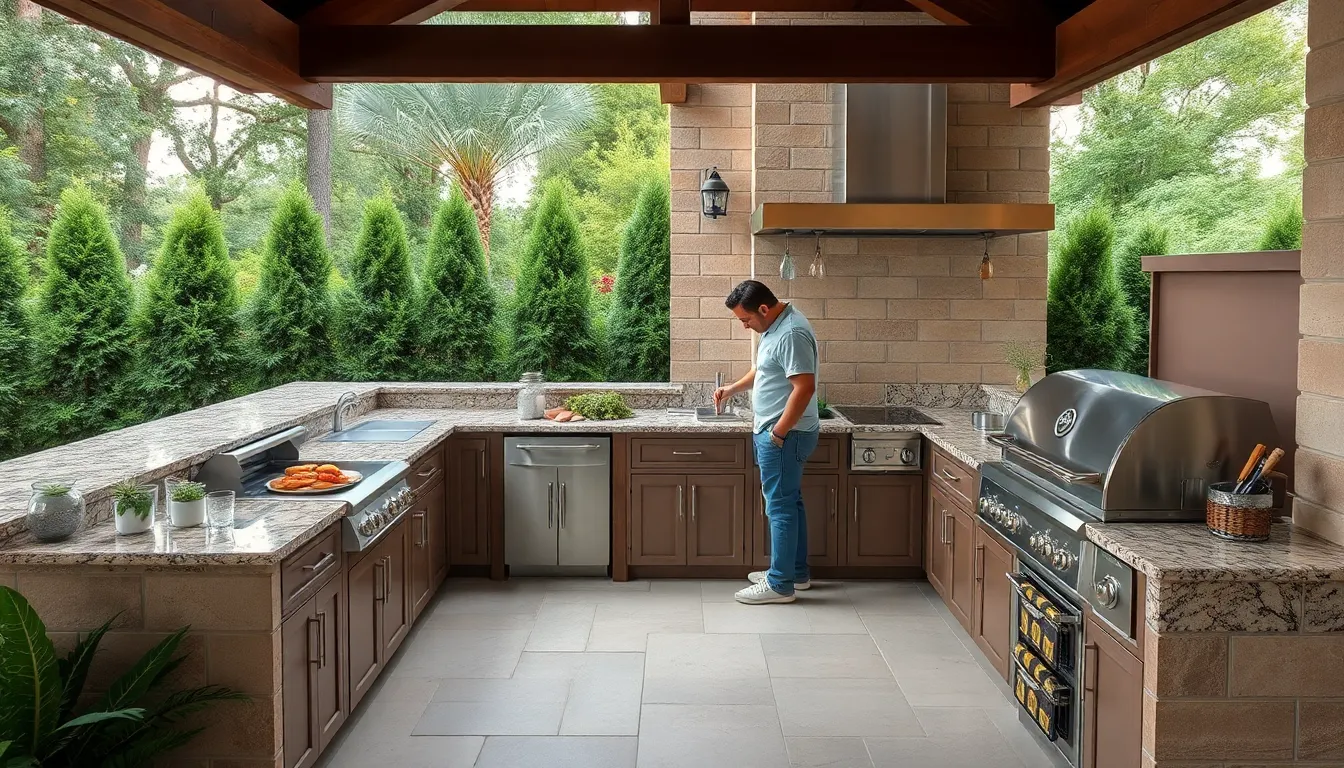
Efficient outdoor kitchen design centers on creating well-planned counter space that supports smooth workflow and food preparation. We’ll organize work zones logically by arranging preparation areas in an L-shaped or island layout that maximizes space usage while providing bar seating for extended dining areas.
Install Heat-Resistant Countertop Materials
Heat-resistant countertops form the foundation of any successful outdoor cooking space. Granite countertops offer exceptional durability against high temperatures and weather conditions while maintaining their appearance over time. Concrete surfaces provide a modern aesthetic and can withstand extreme heat from grills and cooking equipment. Stainless steel countertops deliver professional-grade performance with superior heat resistance and easy maintenance for busy cooking areas.
We recommend installing these materials directly adjacent to grill zones where heat exposure is most intense. Weather-resistant properties ensure your investment maintains both functionality and visual appeal through seasonal changes. Proper material selection prevents warping, cracking, and discoloration that can occur with standard indoor countertop options.
Create Dedicated Zones for Raw and Cooked Foods
Food safety requires establishing clearly defined preparation areas for raw meats and cooked dishes. We position raw food prep zones away from cooked food areas to prevent cross-contamination during outdoor cooking activities. Separate cutting boards, utensils, and washing stations maintain hygiene standards while supporting organized food flow.
Multiple sink installations allow for dedicated handwashing and food preparation areas within your outdoor kitchen layout. Storage compartments keep raw and cooked food items properly separated during meal preparation. Temperature-controlled storage answers ensure food safety compliance while maintaining ingredient freshness throughout extended cooking sessions.
Add Storage Answers for Grilling Tools and Accessories
Built-in storage systems keep grilling tools, utensils, spices, and accessories organized within easy reach of cooking areas. We incorporate weatherproof cabinets and drawers that protect equipment from outdoor elements while maintaining functionality. Specialized storage compartments accommodate different tool sizes and shapes for efficient organization.
Strategic placement of storage answers near grill areas enhances cooking convenience and workspace cleanliness. Pull-out drawers provide easy access to frequently used items without interrupting cooking flow. Covered storage protects expensive grilling accessories from moisture, temperature fluctuations, and UV damage that can reduce equipment lifespan.
Incorporate Essential Appliances and Equipment

Building on our foundation of grilling excellence and storage answers, we need to integrate additional appliances that transform your outdoor space into a fully functional cooking environment. These essential appliances work together to create the versatility and convenience you’ll experience in a complete outdoor kitchen setup.
Add a Side Burner for Sauces and Side Dishes
Side burners give you the flexibility to prepare complete meals without constantly running back to your indoor kitchen. We recommend positioning a side burner within arm’s reach of your main grill to streamline your cooking workflow. This additional cooking surface allows you to sauté vegetables while your steaks sear, or keep marinara sauce warm while your pizza cooks on the grill.
Commercial grade side burners typically produce 12,000 to 15,000 BTUs, providing enough heat for everything from delicate sauces to rapid boiling. Many outdoor cooking enthusiasts find that dual burner configurations offer the most versatility, letting you manage multiple dishes simultaneously. You’ll appreciate having this extra cooking capacity during large gatherings when timing becomes crucial for serving hot food.
Include a Sink for Easy Cleanup and Food Prep
Outdoor sinks eliminate the constant back and forth trips to your indoor kitchen while maintaining proper hygiene standards. We suggest installing a sink with both hot and cold water connections to handle everything from washing fresh produce to cleaning greasy utensils. Stainless steel sinks work best in outdoor environments because they resist rust and handle temperature fluctuations without cracking.
Position your sink between the prep area and grill for maximum efficiency during food preparation. Deep basin sinks accommodate large pots and cutting boards, while pull out spray faucets make cleaning easier. You’ll find that having running water nearby encourages better food safety practices and keeps your outdoor cooking area spotless throughout the entire meal preparation process.
Consider Refrigeration Options for Food Safety
Built in refrigerators keep perishable ingredients at safe temperatures while eliminating trips indoors during cooking sessions. We recommend outdoor rated refrigerators that can withstand temperature fluctuations and humidity changes better than standard indoor models. These specialized units typically feature stainless steel construction and enhanced insulation to maintain consistent cooling performance.
Undercounter refrigerator drawers offer space saving answers for smaller outdoor kitchens while still providing essential cold storage. Ice makers become particularly valuable during summer entertaining, ensuring you always have fresh ice for beverages and food display. Consider refrigeration capacity based on your typical guest count, with compact units suitable for families and larger models necessary for frequent entertaining.
Create Comfortable Seating and Dining Areas
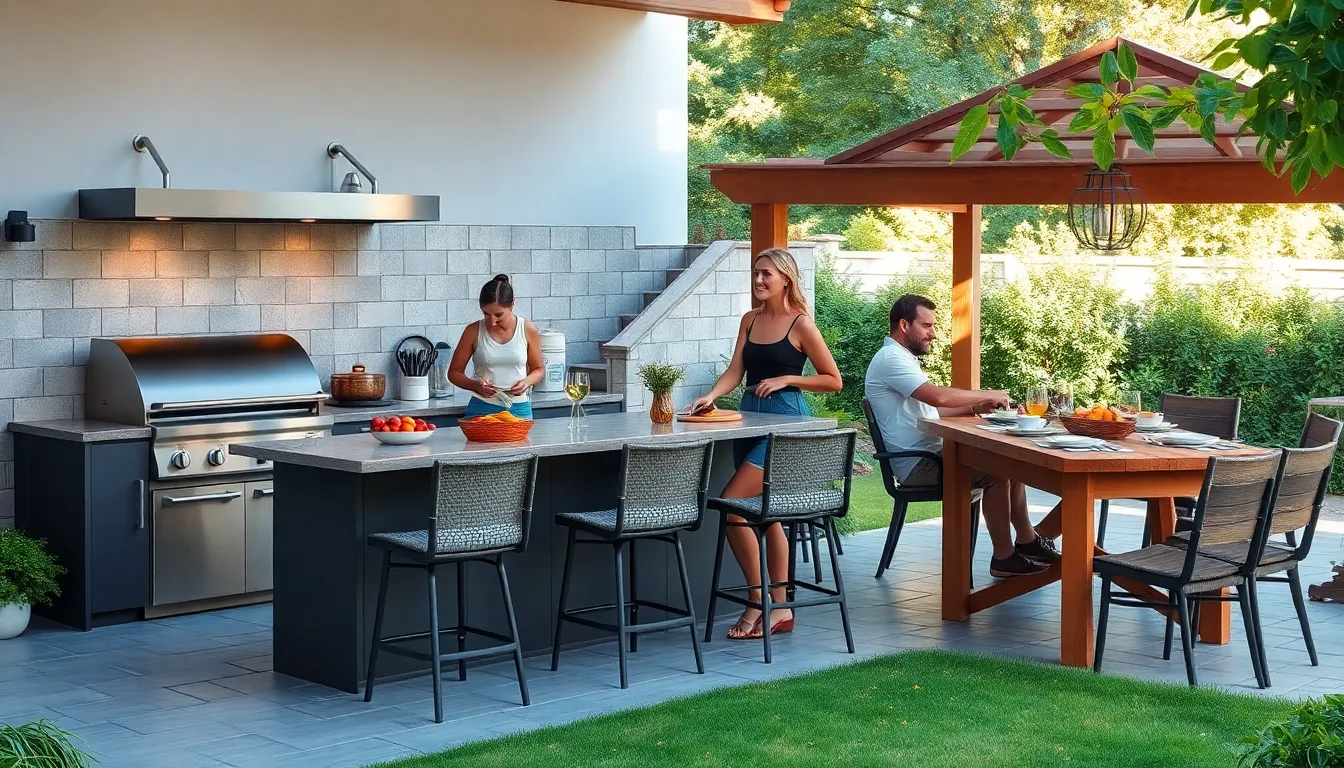
We understand that thoughtful seating arrangements transform outdoor kitchen BBQ setups into inviting social hubs. Comfortable dining zones enhance the overall experience by encouraging guests to gather and enjoy meals in a relaxed atmosphere.
Design Bar-Style Seating Around the Cooking Area
Bar-style seating integrated with outdoor kitchen islands creates an interactive cooking experience where guests can engage with the chef. We recommend positioning bar stools along counters or islands to help conversation while meals are being prepared. This setup efficiently combines cooking and dining zones, making it perfect for casual entertaining and smaller outdoor spaces.
L-shaped or linear island designs extend the available space and naturally incorporate bar seating arrangements. Counter height seating typically ranges from 36 to 42 inches, providing comfortable viewing angles for the cooking process. We’ve found that this configuration works exceptionally well for appetizers, casual meals, and social gatherings where interaction is key.
Plan Separate Dining Spaces for Family Meals
Dedicated dining areas positioned near but separate from the BBQ station provide versatility for different types of gatherings. We suggest creating distinct zones that accommodate formal family dinners and larger group meals beyond casual bar seating. Traditional dining tables with comfortable chairs offer a more relaxed setting for extended conversations and multi-course meals.
Proper spacing between cooking and dining areas improves traffic flow while maintaining the social connection. We recommend positioning dining spaces within 8 to 12 feet of the cooking area to help easy food service. This separation allows for both intimate family meals and larger entertaining scenarios without compromising functionality.
Add Shade Structures for All-Weather Entertaining
Shade structures like pergolas, retractable awnings, and covered decks extend the usability of outdoor kitchen spaces throughout different weather conditions. We prioritize these additions because they protect both cooking and seating areas from sun and rain, ensuring year-round comfort. Covered BBQ stations and dining areas maintain functionality regardless of seasonal changes.
Retractable awnings offer flexibility by providing shade when needed while allowing full sun exposure during cooler weather. Pergolas create architectural interest while supporting climbing plants or fabric coverings for additional protection. We’ve observed that these structures significantly increase the frequency of outdoor kitchen use by making the space comfortable in various weather conditions.
Install Proper Lighting for Evening BBQ Sessions
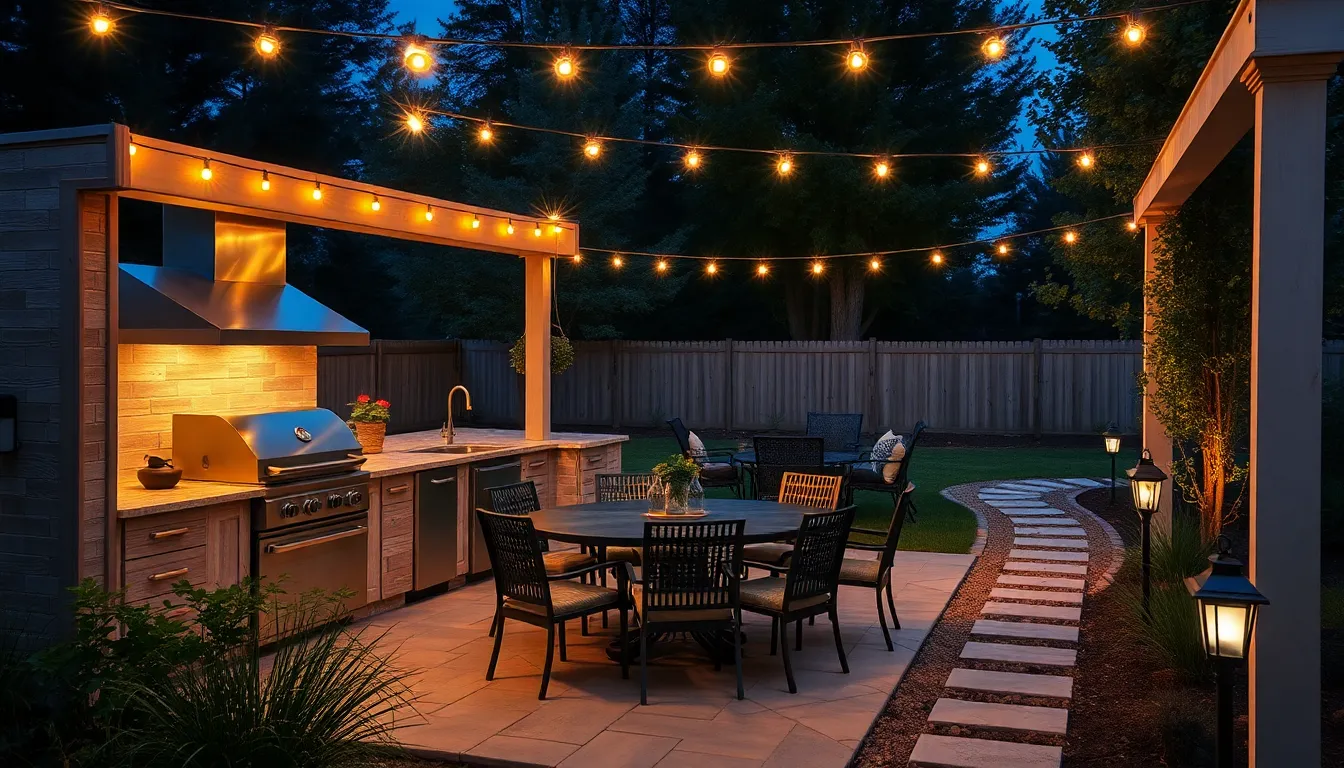
Evening barbecue sessions become significantly more enjoyable and safer when we incorporate proper lighting throughout our outdoor kitchen space. Strategic illumination transforms our backyard cooking area into a functional extension of our home that we can use comfortably after dark.
Use Task Lighting Over Cooking and Prep Areas
Task lighting directly over our grill and prep zones ensures we can cook safely and efficiently during evening hours. Pendant lights mounted above cooking surfaces provide focused illumination that eliminates shadows while we’re handling food and monitoring cooking temperatures. Under cabinet LED strips installed beneath overhead storage or countertops create bright workspace lighting for food preparation tasks like chopping vegetables or seasoning meats.
Adjustable spotlights offer flexibility since we can direct the beam exactly where we need it most during different cooking stages. These fixtures work particularly well when positioned to illuminate both the grill surface and nearby prep counters simultaneously. Professional grade task lighting typically produces 50 to 100 foot candles of illumination, which provides adequate visibility for detailed cooking work without creating harsh glare.
Add Ambient Lighting for Dining and Socializing
Ambient lighting creates the warm atmosphere that encourages our guests to linger and enjoy extended conversations around our outdoor kitchen. String lights draped overhead or along pergola beams provide soft, diffused illumination that enhances the mood without overwhelming the space. Lanterns placed on dining tables or mounted on posts add visual interest while contributing gentle pools of light throughout the seating area.
Soft LED fixtures integrated into our outdoor kitchen design can be dimmed to create different lighting levels for various occasions. Wall sconces mounted on nearby structures or built into outdoor kitchen islands provide consistent ambient lighting that complements our task lighting. These ambient options help define our outdoor dining space as a distinct area separate from the cooking zone while maintaining visual connection between both spaces.
Consider Safety Lighting for Walkways and Steps
Safety lighting prevents accidents by clearly marking pathways and elevation changes that our guests will navigate in the dark. Low level path lights installed along walkways leading to our outdoor kitchen provide guidance without creating light pollution that interferes with our dining ambiance. Step lights mounted directly into stairs or elevated deck areas illuminate each level change, helping prevent trips and falls during evening gatherings.
Solar powered fixtures offer an energy efficient solution for pathway lighting since they automatically activate at dusk and don’t require electrical connections. Motion sensor lights positioned at key transition points provide on demand illumination when guests approach areas like outdoor sinks or storage cabinets. We should ensure safety lighting produces enough visibility to clearly see obstacles while maintaining the overall aesthetic appeal of our outdoor kitchen design.
Plan for Weather Protection and Seasonal Use

Weather protection transforms your outdoor kitchen BBQ setup from a fair-weather luxury into a year-round cooking destination. Smart design choices ensure comfortable cooking and entertaining regardless of seasonal changes.
Install Overhead Structures for Rain and Sun Protection
Pergolas create stylish coverage while maintaining an open-air feel for your BBQ area. These structures filter sunlight during hot summer days and provide partial rain protection during light showers. Gazebos offer more complete weather protection with their enclosed design, making them ideal for regions with frequent precipitation.
Retractable awnings deliver maximum flexibility for changing weather conditions. You can extend them during intense sun or unexpected rain, then retract them when you want full sky exposure. This adaptability makes retractable awnings particularly valuable for outdoor kitchens that need to accommodate different weather scenarios throughout the day.
Solid roof structures provide the most comprehensive protection from rain and sun. These permanent installations create a true outdoor room experience, allowing you to cook comfortably even during moderate storms. Consider materials like metal roofing or polycarbonate panels that withstand outdoor elements while maintaining attractive aesthetics.
Add Windscreens and Privacy Barriers
Strategic windscreens maintain consistent grill temperatures by blocking disruptive air currents. Wind can significantly impact cooking performance, causing uneven heating and making it difficult to control flame intensity. Windscreens create a more controlled cooking environment, especially important for gas grills that rely on steady airflow.
Privacy barriers transform your outdoor kitchen into an intimate dining space. Tall landscaping elements like bamboo screens or evergreen hedges provide natural barriers that enhance the cozy atmosphere. These living barriers also reduce noise from neighboring properties, creating a more peaceful cooking environment.
Decorative screens and walls add both function and visual appeal to your outdoor kitchen. Materials like lattice panels, stone walls, or metal screens can complement your existing design while providing essential wind protection. These barriers also create defined zones within your outdoor space, separating cooking areas from dining or lounging areas.
Consider Heating Elements for Cool Weather Cooking
Outdoor heaters extend your BBQ season well into fall and winter months. Propane patio heaters provide instant warmth that makes outdoor cooking comfortable even when temperatures drop. Electric heaters offer consistent heat output and eliminate the need for propane tank maintenance.
Built-in fire pits create a focal point while providing essential warmth for cool weather gatherings. These features encourage guests to linger longer outdoors, extending your entertaining season naturally. Fire pits also add ambient lighting and create a cozy atmosphere that enhances the overall outdoor dining experience.
Radiant heating systems offer efficient warmth distribution throughout your outdoor kitchen space. These systems can be integrated into overhead structures or installed as standalone units, providing consistent heat without taking up valuable counter or floor space. Radiant heaters work particularly well in covered outdoor kitchens where heat can be contained more effectively.
Integrate Storage Solutions for BBQ Essentials
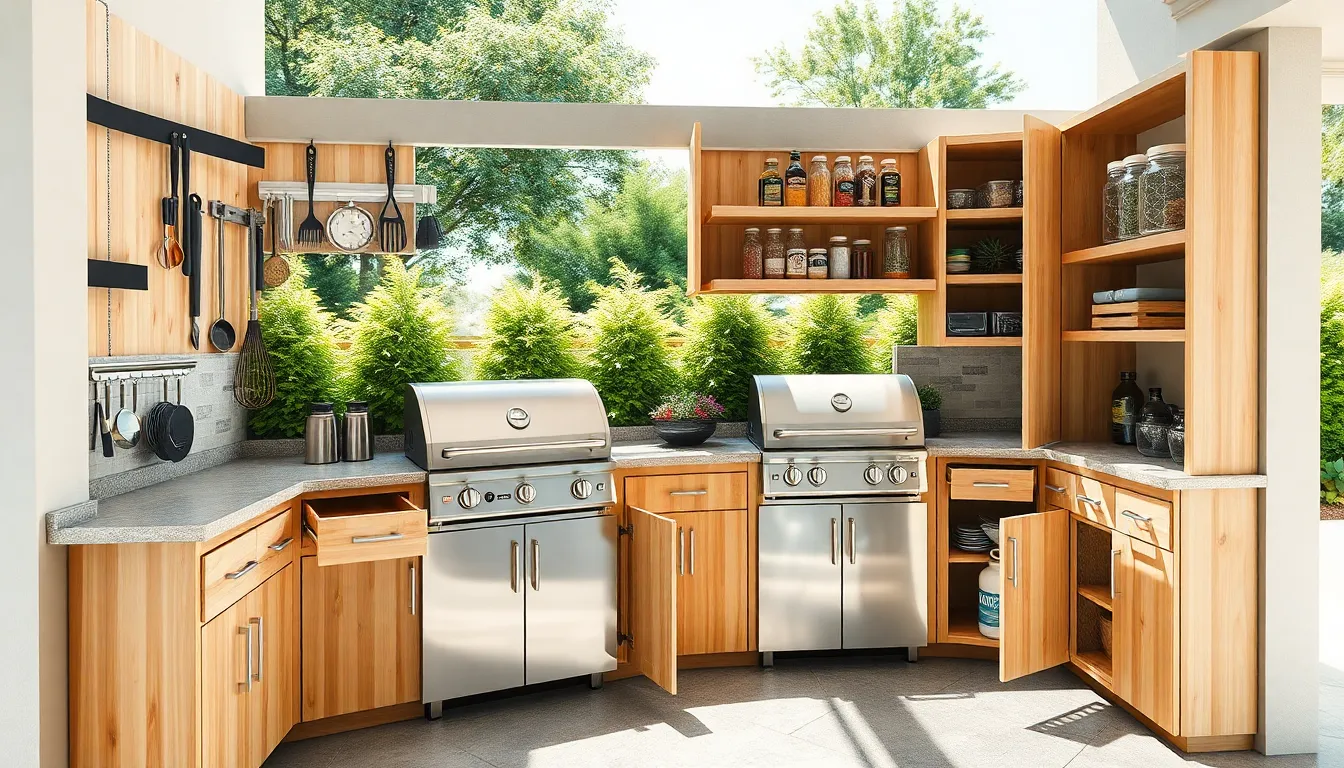
Proper storage transforms your outdoor kitchen into an organized cooking space that enhances functionality and maintains a clean appearance. Smart storage answers keep essential grilling items within easy reach while protecting them from weather exposure.
Design Cabinets for Grilling Tools and Utensils
Custom cabinets maximize storage efficiency by providing dedicated spaces for your grilling arsenal. Weather-resistant materials like marine-grade plywood or stainless steel construction ensure your cabinets withstand outdoor conditions while maintaining their appearance. Drawer organizers create exact slots for spatulas, tongs, basting brushes, and skewers to prevent damage and reduce clutter.
Magnetic strips mounted inside cabinet doors offer convenient storage for metal utensils while keeping them visible and accessible. Pull-out drawers eliminate the need to reach deep into cabinets, making tool retrieval effortless during busy cooking sessions. Hooks and hanging systems inside cabinet doors use vertical space effectively for larger items like grill brushes and long-handled tools.
Modular cabinet systems allow you to customize storage based on your exact tool collection and cooking habits. Soft-close hinges prevent slamming and extend cabinet life in outdoor environments. Ventilation holes in cabinet bottoms prevent moisture buildup that could damage your valuable grilling tools.
Create Pantry Space for Seasonings and Condiments
Dedicated pantry storage keeps your favorite spices, rubs, sauces, and condiments organized and easily accessible during cooking. Enclosed cabinet sections protect ingredients from moisture, pests, and temperature fluctuations that can affect flavor quality. Adjustable shelving systems accommodate containers of various sizes while maximizing vertical storage space.
Clear, airtight containers preserve freshness while allowing you to quickly identify ingredients during cooking. Labels on containers and shelves create a professional organization system that saves time and reduces cooking stress. Lazy Susan turntables in corner cabinets make hard-to-reach items accessible with a simple spin.
Pull-out pantry drawers bring items to you, eliminating the need to search through deep shelves. Temperature-controlled storage compartments protect sensitive items like olive oils and vinegars from heat damage. Spice racks mounted on cabinet doors use otherwise wasted space while keeping frequently used seasonings within arm’s reach.
Add Fuel Storage for Gas Tanks and Charcoal
Safe fuel storage requires dedicated compartments that keep propane tanks and charcoal bags away from heat sources while maintaining easy access. Ventilated storage areas prevent dangerous gas buildup and ensure proper airflow around fuel containers. Lockable doors provide security for expensive propane tanks and prevent unauthorized access.
Sliding tank holders allow you to easily maneuver heavy propane tanks in and out of storage compartments without lifting. Charcoal storage bins with tight-fitting lids keep charcoal dry and prevent pest infiltration while maintaining easy access for refilling. Separate compartments for different fuel types organize your storage and prevent cross-contamination.
Fire-resistant materials like metal construction and proper clearances from heat sources ensure storage safety meets local building codes. Built-in scales or gauges help monitor propane levels so you never run out of fuel during important cooking sessions. Weatherproof seals on storage doors protect fuel from moisture that could affect performance and safety.
Enhance Your Space with Decorative Elements
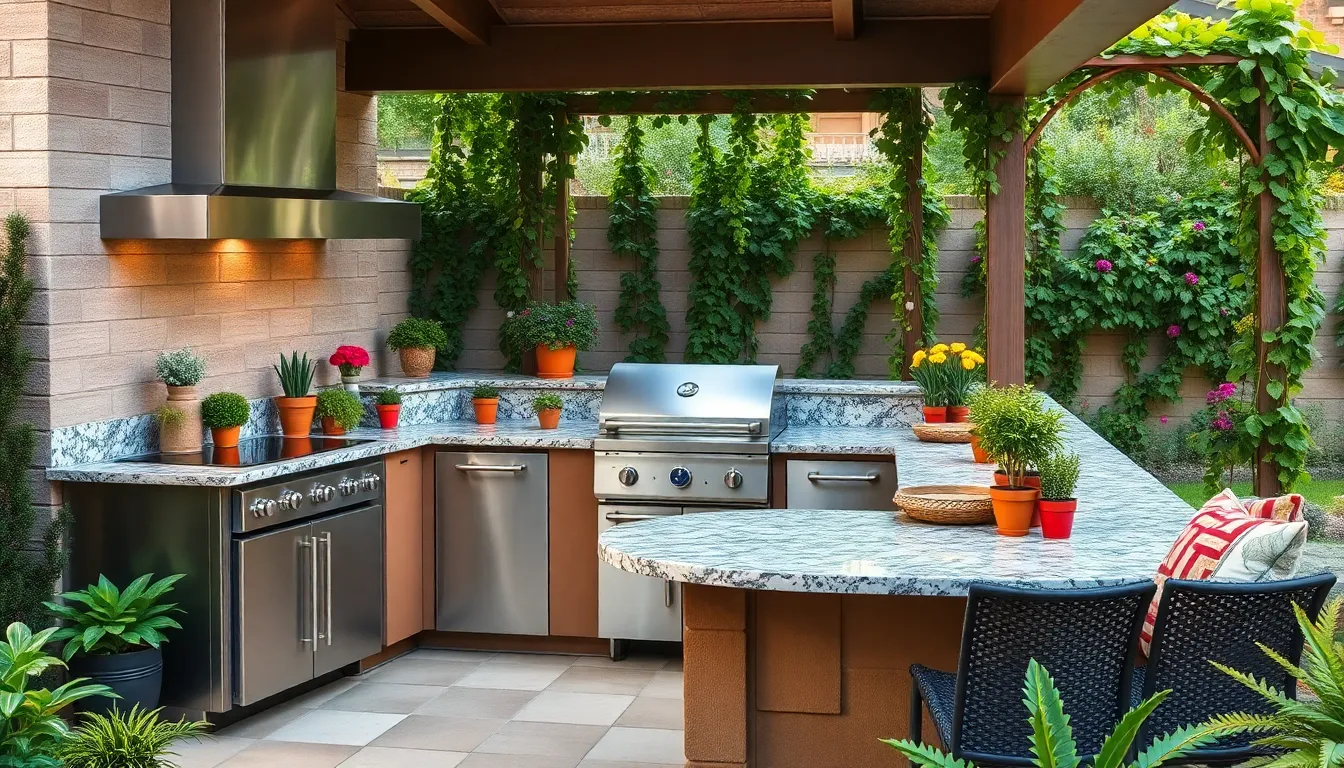
Transforming your outdoor kitchen BBQ area into a stunning entertaining space requires thoughtful attention to visual appeal and functionality. We’ll guide you through essential decorative choices that elevate both style and durability.
Choose Outdoor-Friendly Materials and Finishes
Weather-resistant materials form the foundation of any successful outdoor kitchen design. Granite countertops deliver exceptional performance in hot and humid climates due to their resistance to heat, scratching, and staining once properly sealed. Stainless steel cabinetry offers superior rust resistance and requires minimal maintenance throughout the seasons.
Marine-grade aluminum provides another excellent option for cabinet construction, combining lightweight properties with exceptional corrosion resistance. Natural stone finishes bring authenticity and timeless charm to your cooking space while offering remarkable durability and easy maintenance. Brick surfaces add versatility through various color and pattern options, plus they resist warping and fading over time.
Textured stucco creates Mediterranean or traditional appeal with customizable colors and finishes that complement your home’s architecture. Sleek concrete delivers a modern aesthetic with outstanding durability at a reasonable cost, making it perfect for contemporary outdoor kitchen designs.
Add Plants and Landscaping for Natural Beauty
Strategic landscaping transforms your outdoor kitchen into a lush, inviting retreat that seamlessly blends with nature. Potted herbs positioned near cooking areas provide both practical functionality and fresh greenery for easy access during meal preparation. Shrubs, flowering plants, and ornamental grasses that thrive in your local climate create natural boundaries and seasonal interest around your cooking space.
Garden beds and planters serve as natural dividers between different zones while softening hardscape elements with organic textures. Climbing vines on pergolas or trellises add vertical interest and natural shade over dining areas. Native plants require less water and maintenance while attracting beneficial wildlife to your outdoor space.
Ornamental grasses create movement and texture without overwhelming the cooking area, while fragrant herbs like rosemary and lavender release pleasant aromas when brushed against during cooking sessions.
Incorporate Personal Style with Accessories and Decor
Personal touches transform functional outdoor kitchens into unique expressions of your taste and lifestyle. Colorful cushions for seating areas inject personality while providing comfort for extended entertaining sessions. Decorative lighting options like string lights or lanterns create ambiance and extend usability into evening hours.
Themed decor such as rustic signs or Mediterranean pottery establishes your preferred aesthetic while maintaining outdoor durability. Weather-resistant artwork adds visual interest to blank walls or fence sections without compromising longevity. Outdoor rugs define seating areas and introduce patterns or colors that complement your overall design scheme.
Customized BBQ tool sets displayed on hooks or magnetic strips combine functionality with personal style. Decorative planters in coordinating materials tie together your plant selections with your hardscape choices, creating cohesive visual flow throughout the space.
Budget-Friendly Outdoor Kitchen BBQ Ideas
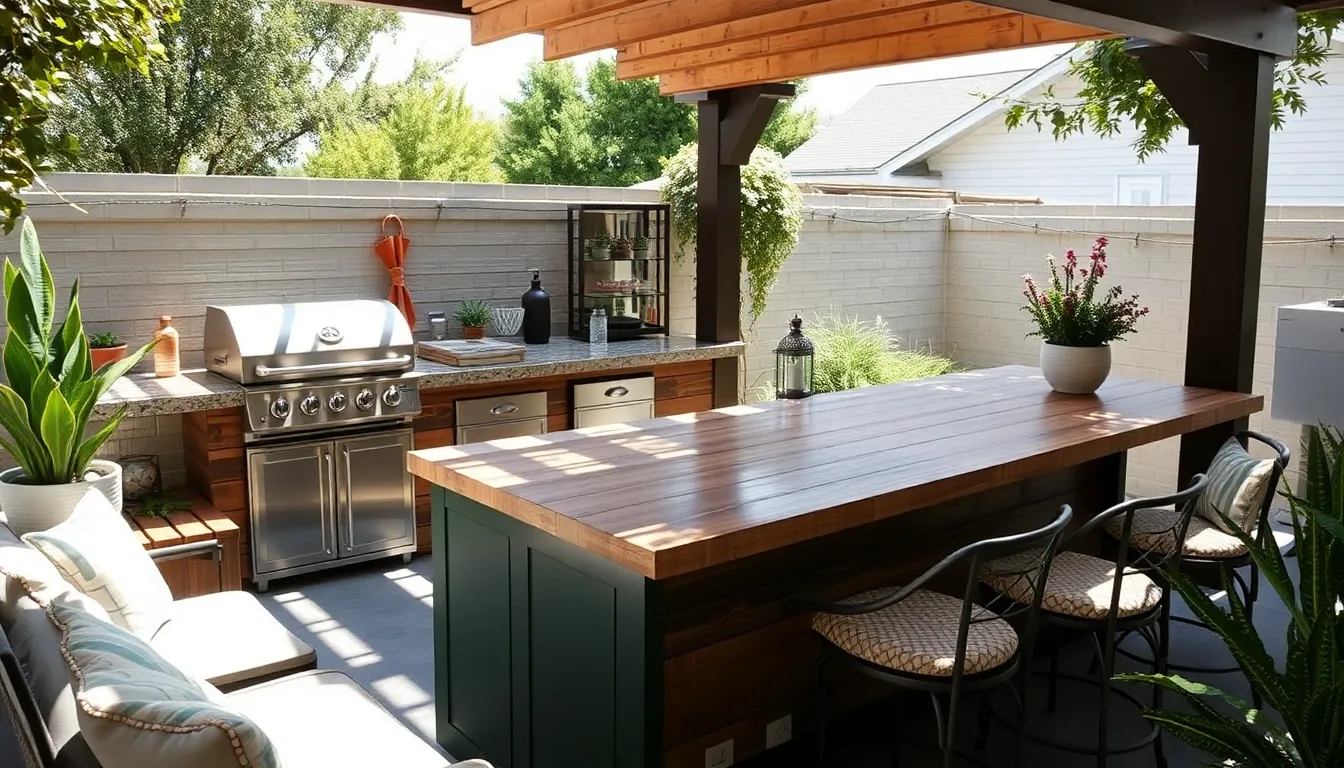
Creating an exceptional outdoor kitchen doesn’t require very costly. We’ll explore strategic approaches that maximize value while building a functional BBQ space that grows with your needs.
Start with Basic Essentials and Expand Over Time
Focus on core components first to establish a functional cooking space without overwhelming upfront costs. We recommend beginning with a grill, prep area, and basic storage as your foundation. A simple linear island with a grill and side prep space works exceptionally well for small yards and provides immediate functionality.
Build incrementally to spread costs over time while customizing your space according to evolving needs. Adding features like bar seating, sinks, or additional appliances becomes manageable when approached as separate projects. This expansion strategy reduces initial investment pressure and allows you to learn what features you actually need through regular use.
Design for flexibility by choosing modular components that can accommodate future upgrades. We suggest planning your layout with expansion in mind, leaving space for additional islands or features. For limited spaces, consider separate islands where the grill area stays near the house while bar seating sits farther away, providing both functionality and design flexibility.
Use DIY Answers for Custom Features
Build custom countertops using affordable materials to achieve high-end looks at fraction of professional installation costs. Repurposing pallets or cinder blocks for grill island bases creates sturdy foundations while keeping expenses minimal. Installing stone or concrete countertops yourself adds durability and style without paying premium labor costs.
Create personalized storage answers through hands-on projects that match your exact needs. We recommend building weather-resistant cabinets using marine-grade plywood and outdoor-rated hardware. DIY outdoor bar seating using concrete blocks and cushions provides comfortable gathering spaces while maintaining budget consciousness.
Customize layout elements to fit your space perfectly without expensive design fees. Building your own prep stations, spice racks, and tool storage ensures every inch serves a purpose. This approach lets you tailor functionality exactly to your cooking style and entertaining preferences.
Shop Smart for Quality Used Equipment
Source gently used appliances through classified ads, online marketplaces, and local store clearances to save hundreds or thousands compared to new purchases. Quality used grills, refrigerators, and sinks often provide reliable performance at important discounts. We recommend inspecting items carefully for functionality and wear before committing to purchase.
Target display models and floor samples from appliance stores and outdoor kitchen showrooms. These units typically show minimal wear while offering substantial savings over retail prices. Many retailers offer warranties on display models, providing peace of mind with your investment.
Consider modular upgrades by purchasing components that can be enhanced or replaced over time. Buying a quality used grill now while planning for future upgrades allows you to enjoy outdoor cooking immediately. This strategy lets you experience different features before investing in permanent installations.
| Budget Strategy | Potential Savings | Implementation Timeline |
|---|---|---|
| Starting with essentials only | 60-70% vs. full build | 1-2 weekends |
| DIY countertops and storage | 40-50% vs. professional | 2-4 weeks |
| Used equipment sourcing | 30-60% vs. retail prices | Ongoing search |
Conclusion
Creating your dream outdoor kitchen BBQ setup is an investment that’ll transform how you entertain and enjoy your outdoor space. We’ve covered everything from selecting the perfect location and choosing the right grill to designing functional storage and adding weather protection features.
Remember that building your outdoor kitchen doesn’t have to happen overnight. Start with the essentials and gradually expand your setup as your needs and budget allow. Whether you’re working with a generous budget or taking a more cost-conscious approach there’s a solution that’ll work for your space and lifestyle.
The key is planning thoughtfully and focusing on functionality first. With the right combination of equipment storage and design elements you’ll create an outdoor cooking space that becomes the heart of your backyard gatherings for years to come.
Frequently Asked Questions
What are the key benefits of installing an outdoor kitchen BBQ setup?
Outdoor kitchen BBQ setups enhance outdoor entertaining, add significant value to your home, and create a versatile cooking space that extends your living area. They provide a dedicated space for grilling, reduce indoor cooking heat during summer, and create a natural gathering point for family and friends, making every meal an outdoor adventure.
How do I choose the perfect location for my outdoor BBQ kitchen?
Select a location close to your indoor kitchen for easy access to utilities like water, gas, and electrical connections. Consider wind patterns to avoid smoke issues, ensure adequate space for traffic flow around cooking zones, and evaluate the need for weather protection features like pergolas or awnings for year-round usability.
What type of grill should I choose for my outdoor kitchen?
Choose based on your cooking preferences: gas grills offer convenience and quick startup, charcoal grills provide authentic smoky flavor, and pellet grills combine versatility with digital controls. Consider your entertaining needs – small grills work for casual meals, while larger grills suit frequent gatherings and bigger groups.
What countertop materials work best for outdoor kitchens?
Heat-resistant materials like granite, concrete, and stainless steel are ideal for outdoor kitchens. These materials withstand high temperatures, outdoor weather conditions, and frequent use. They’re also easy to clean and maintain, ensuring your outdoor kitchen remains functional and attractive for years to come.
What essential appliances should I include in my outdoor kitchen?
Key appliances include a side burner for sauces and side dishes, an outdoor sink with hot and cold water for cleanup and prep, and a built-in refrigerator for food safety. These appliances create a fully functional cooking space that reduces trips indoors and enhances your outdoor cooking experience.
How can I create comfortable seating and dining areas?
Design bar-style seating around cooking areas to encourage interaction between guests and the chef. Include separate dining spaces for family meals to accommodate different gathering types. Add shade structures like pergolas or retractable awnings to ensure comfort in various weather conditions and extend usability year-round.
What lighting options work best for outdoor BBQ kitchens?
Install task lighting over cooking and prep areas for safety and visibility while cooking. Add ambient lighting to create a warm atmosphere for dining and socializing. Include safety lighting for walkways and steps to prevent accidents during nighttime gatherings and ensure overall safety.
How can I protect my outdoor kitchen from weather?
Install overhead structures like pergolas, gazebos, or retractable awnings for rain and sun protection. Add windscreens and privacy barriers for comfortable cooking conditions. Include heating elements such as propane heaters or built-in fire pits to extend your outdoor cooking season into cooler months.
What storage solutions work best for outdoor BBQ essentials?
Design custom cabinets using weather-resistant materials for grilling tools and utensils. Create dedicated pantry space for seasonings and condiments. Ensure safe fuel storage with ventilated compartments and fire-resistant materials for gas tanks and charcoal, maintaining both organization and safety.
Can I create an outdoor kitchen on a budget?
Yes! Start with basic essentials like a grill, prep area, and basic storage, then expand over time. Use a DIY approach for custom features, choose affordable materials, and repurpose existing items. Shop for quality used equipment to save money while still achieving a functional and attractive outdoor cooking space.

